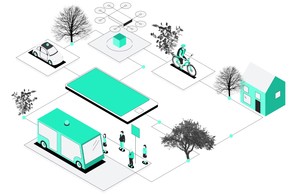Snowdonia Aerospace has today launched a public consultation, open to everyone, on a proposed change to the airspace designation around Llanbedr Airfield. The consultation begins on Monday 7th December 2020 and will run for 7 weeks before closing on Friday 22nd January 2021.
The Snowdonia Aerospace Centre (SAC) is a UK centre of excellence for testing of next-generation aircraft, such as “drones-for-good”, electric aircraft, urban and regional air mobility vehicles, high altitude balloons, airships and near-space testing vehicles. The proposed airspace change is to create a permanent Danger Area that will enable SAC to further develop the site and support increased innovation in the UK aerospace sector particularly within these emerging technology markets. It is not associated with military training.
The Danger Area will be permanent in terms of its designation but will be “active” only as and when required, otherwise it will remain open to all air traffic. Ninety per cent of the operations using the Danger Area will be over the airfield or out over the sea. The proposal is part of a sustainable longterm Masterplan for Llanbedr Airfield that could contribute up to 515 jobs and £19.5m per year to the local economy once full developed.
SAC has produced a Consultation Document that explains the proposed changes, including detailed maps and environmental analysis, plus a three-page “easy-read” guide in English and Welsh. These documents and the Consultation Questionnaire can be accessed via the Civil Aviation Authority
online portal.
SAC will also be hosting drop-in sessions where members of the public will be able to ask questions and find out more about the proposal. These sessions will be held in the Main Hangar at Llanbedr Airfield, with appropriate Covid-19 measures in place:
• Thursday 10th December 2020, 10am to 4pm
• Friday 11th December 2020, 10am to 4pm (Welsh speaking available)
• Saturday 12th December 2020, 10am to 2pm
Postal responses can be submitted to:
Airspace Change
Snowdonia Aerospace Centre
Llanbedr, LA45 2PX
SAC will be happy to answer any further questions via email: [email protected] or
phone: 01341 360038.
Lee Paul, CEO of Snowdonia Aerospace said:
“We are continuing to develop complementary business opportunities at Llanbedr Aerodrome relating to aerospace Research, Development, Test and Evaluation (RDT&E).To support these operations it has now become necessary for us to seek to upgrade and formalise the current airspace
around the Aerodrome as the present provision is insufficient to meet the identified future need and risks restricting opportunities that are in the strategic economic interest of the UK and Welsh governments.
Llanbedr has long been a UK national asset for aerospace RDT&E and there has been increased demand in recent years given its ideal location for Beyond Visual Line-of-Sight (BVLOS) drone testing. These activities have been satisfied to date by the use of a Temporary Danger Area, but both customer demand and the need for confidence and reliance are now such that an application for a Permanent Airspace Change is warranted.
Moving to a permanent Danger Area will allow an increase in throughput to satisfy the market need and provide UK businesses in these sectors with a surety of being able to operate in the UK on a reactive basis. Many UK businesses have chosen to undertake their testing abroad due to the
uncertainties around availability of adequate and appropriate commercial trials environments.
Particularly during these unprecedented times it is imperative that we encourage UK innovation and support UK businesses to operate within the UK. All Dangar Areas in the UK are presently managed and controlled on behalf of the MOD with limited opportunities for commercial use and exploitation.
The establishment of a Permanent Danger Area, the first civilian managed airspace of this type and dedicated to support UK businesses in the emerging aviation sectors, will act as a catalyst to aid economic recovery and support long term sustainable jobs.
John Idris Jones, Chair of the Snowdonia Enterprise Zone Advisory Board, said:
The Snowdonia Enterprise Zone Board welcomes this consultation by the SAC and encourages local stakeholders to get involved.. This airspace designation change is a key enabler in the longer term development of the site as a location for quality job opportunities in space related research
and development and the evaluation of aircraft being developed to use low carbon fuels to meet the Government’s 2050 carbon emissions reduction target.
Cllr Gareth Thomas, Cabinet Member (Economy and Community), Gwynedd Council, said:
We have long supported the development of Snowdonia Aerospace Centre for the development of civil novel aircraft and space technologies, in order to create sustainable high-value jobs in Meirionnydd and across the wider region. We are pleased to see that steps are being taken to allow for the safe piloting of these technologies, and would encourage anybody in the community with an interest in the site to respond to the consultation.
John Whalley, CEO of Aerospace Wales, said:
Aerospace Wales is the industry association for the sector working in close co-operation with Welsh Government on future strategy. This proposal by Snowdonia Aerospace Centre is hugely important in ensuring that Llanbedr will play a lead role in the development of future flight concepts for the
benefit of both the local community, the people of Wales and the wider UK aviation community. The technologies developed will help support a more sustainable future and the creation of high value added jobs. I would encourage everyone to get involved and help shape the future.
The Consultation runs from 7th December 2020 to 22nd January 2021.





